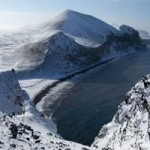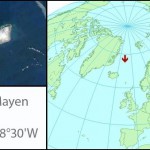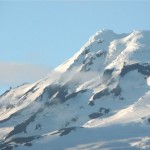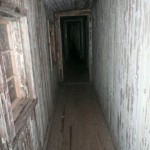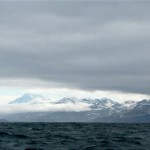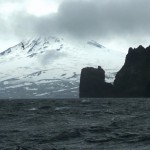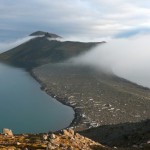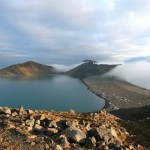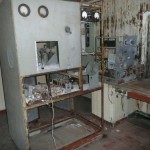JX/G7VJR and JX/SQ4MP took place between 25 June and 6 July 2008 by Michael G7VJR and Wojtek SQ4MP. The main purpose of our visit was amateur radio, and we were active as much as possible – except when propagation was not available (about 6 hours each day). We were mainly on CW on 20m and 30m, where we were looking particularly for DX outside Europe. Wojtek also made many RTTY QSOs.
We used lightweight vertical antennas, an Elecraft K2/100 radio and a Yaesu FT-857D with generators. Our location was IQ51, Gamlemetten (north West Jan Mayen), a new square for 6m.
Where is Jan Mayen?
Jan Mayen is a small volcanic island (34 miles long) approximately 400 miles north of Iceland, and 300 miles east of Greenland. It is a Norwegian territory and is the product of volcanic activity, with the most recent eruption being in 1985.
At the north of the island, Beerenberg towers 2277m above the sea, while in the south the Norwegian base housing the Loran C navigation radio station is manned by a crew of approximately 18.
The globe projection shows you the location and the satellite map clearly shows Beerenberg.
Jan Mayen is not an easy location to reach. The main challenge is that, although there is a Norwegian base, visitors cannot use the facilities there and there are no ports or other air strips. Most of the northern coastline soars from the ocean onto the sides of Beerenberg, so to approach with a RIB, only a few landing areas are a possibility.
One is the very slender isthmus, where good coverage to the west is possible.
My trip was with an adventure touring company, EcoExpeditions, managed by Geir Ulstein from Norway. As the only non-military visitors to Jan Mayen, and the only way a non-national will ever reach Jan Mayen, it was a real adventure! We travelled on a 60ft sailing boat from Dalvik, northern Iceland, and the journey took 60 hours each way (a very strange and seemingly endless experience).
Other members of our group ascended Beerenberg, but as you can appreciate Wojtek and I stayed at the base working on the radio as much as possible. Of course, one benefit of visiting in summer was the midnight sun, so we did not have to work in the dark at any point (although we paid for it – no 160, 80 or 40m QSOs were made).
There are ample supplies of drift wood to use for fuel (as seen in the photos), although Jan Mayen itself has no native trees, or indeed animals other than migratory birds.
Jan Mayen is difficult to work from North America, and one reason for this is that the base – which is where, understandably, most Norwegian operators will be – is not well-sited for working the states. We were able to land on the west coast at Gamlemetten, an excellent QTH for North America. As a result, we were very pleased to work very large numbers of DXers in America, and also in Japan, Australia and even New Zealand.
Propagation
Auroral activity closes the lower bands and may disrupt all bands, and of course right now we also have a lack of sunspots, which means that higher bands are not open reliably.
The auroral skirt lies between Jan Mayen – North America, especially the west coast, making this one of the most challenging paths. To Europe, the aurora will sometimes not extend fully south and at those times propagation should be excellent on 20m and 30m. This is exactly the experience we had.
On lower bands such as 40m, the absorbing effects of even marginal aurora completely flatten the band, and remember that in summer there is no darkness. For this reason, 40m, 80m and 160m were not possible (or not a good use of our time for those few near enough to hear us).
We used 100W CW on 30m, 20m and 17m. We listened (and CQ’d) on other bands, but no-one replied, even when we used 600W. When our linear broke on day 3, and we went back to 100W, we decided to focus on the bands which were really open.
We used CW to get a little further. JX9JKA provides very many SSB QSOs and is doing a great job on that mode, so we felt it was a good idea to focus on CW. Also, by using CW we could run beacons, save our voices and even get some sleep! Wojtek did some RTTY and worked a lot of DX, even with just 75W.
Strong 20m openings to JA were available reliably every day, around 1100Z to 1400Z, and we had a great 30m opening at night (0200Z to 0600Z) to NA. We also managed to work KH6, LU, VK and ZL on 20m, where our 18m high vertical for 20m did a great job.
6m – The Magic Band
6m provided several dramatic openings while JX/G7VJR was QRV! The band opened for about 5 hours each day, from 1600Z to 2200Z. I worked 300 stations across Europe and north Africa on 6m, including some all-time new ones:
- Azores – CU3EQ 01 July 2008
- Balearic Islands – EA6SX 30 June 2008
- Hungary – HA0DU 01 July 2008
QRG for JX/G7VJR was 50.105MHz CW, and I used a beacon (as well as monitoring with headphones) for about 8 hours each day. Although this meant sacrificing some HF QSOs, this was more than made up for by Wojtek and provided a “new one” for many keen 50MHz enthusiasts. Thank you guys!


